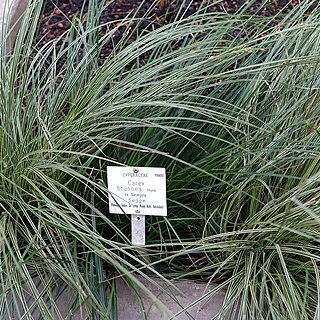Rhizome very short, woody. Stems tufted, slender, erect, triquetrous, smooth, or scaberulous on the angles above, (10-)30-100 cm by 0.5-1.5 mm, surrounded below the leaves by dull brown bladeless sheaths tending to split in front into reticulate fibres. Leaves subbasal, shorter to longer than the stems, rigid, flattish or condupli-cate, rarely subfiliform, usually asperous above, gradually attenuated towards the apex, (1-)2-6 mm wide. Inflorescence with (2-)4-8 fascicles of 2-7 spikelets (rarely all the spikelets solitary), narrow, erect or more or less nodding, c. 5-50 cm long, upper fascicles or spikelets approximate and some fastigiate, lower rather distant, one of the spikelets at each node (especially at the lower ones) usually longer than the others and with some smaller spikelets branching from it. Spikelets erect or suberect, cylindric or narrowly cylindric, rather densely to rather loosely flowered, androgynous (female part usually much longer and thicker than the male part, 2-4 mm thick), 1-4.5 cm long, upper sessile or subsessile on included or shortly exserted peduncles, lower on long-exserted, smooth or scaberulous peduncles. Lower bracts foliaceous or subfoliaceous, longer than their fascicles but usually shorter than the inflorescence, long-sheathing, upper bracts much reduced. Glumes from much shorter than to almost as long as the utricles, ovate to ovate-lanceolate, acute to obtuse, glabrous, obsoletely nerved but distinctly 3-nerved in the centre, muticous or apiculate, rarely an awn to 2 mm present, light castaneous, sometimes with whitish-hyaline margins, 2-4(-5) mm long. Utricles ovoid to oblong-elliptic, plano-convex, membranous, prominently multinerved, shortly whitish setulose at least on the margins, suberect, cinna-momeous to castaneous, cuneately tapering to a 0.5-1 mm long stipe, subabruptly beaked, 2½-5(-6) by 1-1.5 mm; beak ½-2 mm, bidenticulate. Nut ovate or oblong-ovate, compressed-biconvex, scarcely stipitate and beaked, stramineous, 1.5-2.5 by 1-1.25 mm. Style-base slightly thickened. Stigmas 2 (or rarely 3), up to about as long as the utricle.
More
Rhizome short, without stolons. Culms densely tufted, slender, 40-70 cm tall, triquetrous, smooth, many leaved at base. Leaves longer or shorter than culm, blades 2-3 mm wide, conduplicate proximally, distally gradually flattened, scabrous on both surfaces and margins, sheathed; sheaths short, usually less than 5 cm, splitting at membranous part. Involucral bracts sheathed, lower involucral bracts blades leaflike, upper blades setaceous; sheaths 7-20 mm, brownish green. Spikes few to more than 10, usually 1 or 2 in an involucral bract sheath, not branched, distance between 2 spikes up to more than 10 cm, spikes androgynous, male part much shorter than female part, cylindric, 1.5-3 cm, densely many flowered, pedunculate; peduncles short at upper part, long at lower part. Female glumes yellowish brown, shortly brown striate, ovate, ca. 2.5 mm, membranous, 3-veined, apex acute or obtuse, muticous. Utricles brown, suberect, longer than glume, elliptic or suborbicular, compressed plano-convex, 3-3.5 mm, membranous, thinly 9-veined abaxially, white hispidulous on both surfaces, base abruptly contracted into a short stipe, apex abruptly narrowed to a short beak, beak less than 1 mm, 2-toothed at orifice. Nutlets yellow-brown, tightly enveloped, suborbicular, compressed biconvex, base estipitate; style base slightly thickened; stigmas 2. Fl. and fr. Jun-Oct.
Primary forest, mossy forest, exposed ridges, grassy slopes, (80-)800-2800(-3100) m, in Lombok in monsoon forest scrub on dry calcareous soil, 200-400 m, in W. Sumatra on limestone hills.

